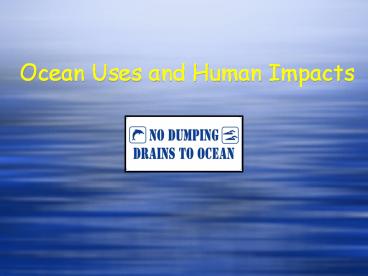Ocean Uses and Human Impacts PowerPoint PPT Presentation
Title: Ocean Uses and Human Impacts
1
Ocean Uses and Human Impacts
2
Outline
- Marine Resources
- Minerals and gas
- Energy
- Biological
- Mariculture
- Drugs
- Marine pollution
- Invasive species
- Coastal development
- Climate Change
3
Classes of Marine Resources
- Physical resources
- Mineral deposits, petroleum, natural gas,
freshwater - Biological resources
- Plants and animals, microbes
- Marine energy resources
- Energy from heat or motion of water
- Non-extractive resources
- Transportation, recreation, waste disposal
4
Petroleum and Natural Gas
- Oil and gas are often found together beneath
impermeable caprock. Drilling for oil offshore
requires specialized equipment and is more costly
than drilling on land.
5
Salts and Minerals
- Magnesium
- Sodium chloride
- Manganese nodules
- Phosphorite
- Metallic sulfides and muds
6
Fresh Water
- Only 0.071 of Earths water is liquid, fresh,
and available at the surface for humans - More than 1500 desalination plants worldwide
- 3.5 billion gallons/day
- Towing icebergs?
7
Marine Energy Wave Motion
- Energy generated by waves and tides
8
Ocean Energy Thermal Gradient
9
Biological Resources
- Major types of commercially harvested fishes,
crustaceans, and mollusks
10
Biological Resources
World Commercial Catch of Marine Fishes, Crustaceans, and Mollusks, by Species Group, 1997 World Commercial Catch of Marine Fishes, Crustaceans, and Mollusks, by Species Group, 1997
Species Group Millions of Metric Tons
Herring, sardines, anchovies 21.5
Jacks, mullets, sauries 10.9
Mollusks 15.5
Cods, hakes, haddocks 10.2
Redfish, basses, conger eels 7.4
Crustaceans 6.8
Tunas, bonitos, billfishes 4.8
Mackerel, snooks, cutlass fishes 5.2
Flounders, halibuts, soles 1.0
Miscellaneous Marine Fishes 17.5
Total for all sources 100.8
Table from Garrison, 4ed
11
Potential Harmful Impacts of Mariculture
- Escape of non-native species
- Herbicides
- Disease tolerance and spread
- Nutrient enrichment -gt eutrophication
12
Drugs
- Researchers estimate that 10 of marine species
may contain useful medical compounds - Acyclovir, the first antiviral compound approved
for humans, is derived from a Caribbean Sea
sponge - Pseudopterosins, a class of anti-inflammatory
drugs, is derived from marine species - Bone substitute for speeding regrowth of bone
grafts is available from Corals. Coral skeletal
structure is remarkably similar to human bone
13
Marine Pollution
- Crude oil spills are usually larger in volume,
and occur more frequently than spills of refined
oil. - Refined oil spills can be more disruptive for
longer periods of time. Components added to oil
in the refining process make it more deadly.
14
Marine Pollution - DDT
- Levels of organic pollutants may be low, but
biological amplification concentrates harmful
toxins - The concentration of DDT in the fatty tissues of
organisms was amplified up to 10 million times in
a food chain off the coast of New Jersey
15
Marine Pollution
16
Invasive Species
- Introduced species crowd out native species,
alter habitats, and impose economic burdens on
coastal communities. - The rate of marine introductions has risen
exponentially over the past 200 years and shows
no sign of leveling off. - More than 175 species of introduced marine
invertebrates, fish, algae, and higher plants
live in San Francisco Bay. - http//www.invasivespecies.gov/
17
Invasive Species Zebra Mussel
18
Recent US Bioinvasions
http//www.pewoceans.org/reports/introduced_specie
s.pdf
19
Coastal Development
- Sprawl development is consuming land at a rate of
five or more times the rate of population growth
in many coastal areas. Sprawl needlessly destroys
wildlife habitat and degrades water quality. - More than one-fourth of all the land converted
from rural to suburban and urban uses since
European settlement occurred during the 15-year
period between 1982 and 1997 (the last year for
which such figures are available) (NRI, 2000). - Coastal marshes, which trap floodwaters, filter
out pollutants, and serve as nurseries for
wildlife, are disappearing at a rate of 20,000
acres per year. Louisiana alone has lost half a
million acres of wetlands since the 1950s.
20
Coastal Development
21
Coastal Development - Vehicle Miles
22
Global Warming
23
- A 1-mile-per-gallon improvement (in average
vehicle fuel efficiency) would yield double the
oil that could ever be extracted from the Arctic
National Wildlife Refuge -- and would do it
without destroying the countrys last great
wilderness. A 2.6 mpg improvement would produce
more oil than we import from Iraq and Kuwait
combined. An 8-mpg increase would eliminate the
need for all Persian Gulf imports. - RF Kennedy, jr, in Crimes Against Nature
24
Ice and climate
25
(No Transcript)
26
Glaciers in retreat worldwide
27
Great Aletsch Glacier (Switzerland)
1858
2001
28
(No Transcript)
29
(No Transcript)
30
Antarctic Ice Sheet
31
Antarctic Ice Sheet
EAIS
WAIS
32
(No Transcript)
33
(No Transcript)
34
Both Greenland Ice Sheet and West Antarctic Ice
Sheet 6 m global sea level. 25 of U.S.
population lives within 10 m of sea level.
WAIS
35
The Prez
36
People at risk
- Country population annual incomeBangladesh 11
5 million 160Egypt 55 million 710Indonesia
185 million 450Maldives 0.2
million 300Pakistan 110 million 350
37
Challenge for Your Generation
- 1870-1900 Railroad system built
- 1940-1970 Interstate highway system
- 1960-1970 Apollo mission to the Moon
- 1950-1990 Cold War, nuclear threat
- 1960-1980 Green revolution, agriculture
- 1990-2010 Recognizing climate change
38
Everyone Likes a Challenge
- 1990-2010 Recognizing climate change
- 2010-???? Mitigation and Adaptation

